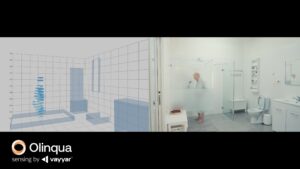In today’s high-demand healthcare landscape, it is more important than ever we focus on improving patient outcomes. As a result of our ageing population, rising rates of chronic disease, and the aftermath of the recent pandemic, patients require and expect more when it comes to their care, and when seeking and selecting services from our healthcare system.
While the solution to delivering better patient outcomes is undeniably multi-faceted, an important piece of the puzzle is the introduction and adoption of technology that powers improved collaboration in hospitals, both through enhanced communication and better use of data. Healthcare professionals, like everyone else, need to be truly connected.
We know that outside of hospitals, Australians are already highly digitally connected. Australia’s National Digital Health Strategy tells us that 103 mobile banking visits take place per person per year, 17 million people are on Facebook, and 84% go online first for health information. With this in mind, it is understandable why we expect connection, digital tools and technology best practices to carry through to the healthcare we receive.
We also already know that different systems and devices are actively being used in hospitals and other healthcare settings to assist with connection – from mobile phones to sensors, to alarms. These varying systems and devices not only connect people and enable communication but, while doing so, also produce incredible volumes of data that, when collated and analysed, can better enable decision-making and streamline processes.
Enabling this collation to occur in milli-seconds, effectively producing real-time alerts and insights, further improves the accuracy and timeliness of those decisions and actions.
But while research and reports tell us the adoption of ‘connection’ is already well underway, the adoption of integration technology that empowers effective collaboration, and those milli-second insights, is much more gradual. And, it’s only when we really embrace integration solutions, that we will truly be able to 1) take advantage of the granular data that is now available to us and the insights it provides, and 2) really start to move the needle and optimise patient care in ways we could never have imagined before.
What is real-time data sharing, and why is it important?
When it comes to hospitals and other healthcare systems, the sheer volume of data is unfathomable for many of us. From patient medical records and personal profiles to detailed information regarding assets such as bed and wheelchair availability, every tangible and intangible element within a hospital is able to be documented, tracked and monitored.
By collating data from across different systems and making it accessible, healthcare providers can gain a more comprehensive view of each patient’s medical history, current condition, and treatment plan in real-time.
They can better plan and schedule diagnostic tests, treatments, and access to specialists, and monitor patients 24/7, rather than intermittently. This can be especially useful for patients with chronic conditions, where ongoing monitoring is critical for managing symptoms and preventing complications.
Importantly, they can also ‘see’ every aspect of that hospital operationally, learning when refrigeration units fail, and assets like blood are at risk, and knowing when any wheelchair is taken off hospital property, and which boundaries it crosses.
Real-time data sharing enables all of these same insights – a split second after they occur.
Healthcare staff can have absolute visibility, without any information delay, enabling the immediate mitigation of risks, to prevent everything from a fall to assets being stolen.
But how is this possible? It’s one task to bring everything together; it’s another entirely to draw out those insights straight away, and make them available to whoever is seeking them, right when they need them most.
The answer is integration platforms, like Olinqua’s ‘Ignite’ solution.
Like a puzzle, integration allows for all of the pieces of a hospital – the patients, the staff, the equipment and machines, the beds, the rooms – every single element, to come together to show the highly-detailed, big picture, as it is at any single moment.
It takes any number of disparate systems that have previously worked largely in a silo, and enables them, as part of a network that reaches from one end of the hospital to the other (figuratively), to combine their intel and form a more comprehensive and complete image of every aspect of that living, breathing environment.
Integration is the key to connection and collaboration, but it is also crucial to critical staff getting the answers they need to enable the most informed and accurate patient healthcare decisions.
For more detailed information on how real-time monitoring can be applied to a hospital’s duty of care for staff, be sure to check out our blog post: The Power of Real-Time Location Systems in Supporting Patient and Staff Safety
How to implement integration software effectively
Over more than 10 years, Olinqua has worked with hospitals to enable the implementation of technology, like our integration platform, that streamlines and improves operations, communication and workflows. And what have we learned? Selecting the right solution is only step one!
The below high-level insights can guide your thinking as you approach the implementation of an integration solution.
- Ensure data quality
As we’ve touched on above, seamless real-time data sharing only works as well as the quality of data circulating within the software platform. If the data isn’t up-to-date or accurate, it will be of no use to healthcare providers, and it will more than likely achieve the opposite result than intended when it comes to patient outcomes.
To ensure data is accurate and up-to-date, healthcare providers should establish data governance policies and procedures, including data standards, data quality checks, and audits, to review data regularly for completeness and accuracy.
To quote the Australian Institute of Health and Welfare, “Now and in the future, high-quality digital information remains an important aspect of health care”.
- Train staff
Following on from data quality and accuracy, training is essential to ensure staff are capable of capturing accurate data and also on how to use the integration software effectively and to its fullest degree. This can include training on how to input data, access data, and interpret data.
At Olinqua, we feel delivery of both the software AND the service deserve equal attention. That is why we offer consulting and support throughout the entire process – from initial discussions to planning and implementation, to post-implementation support. We know the power of staff training!
- Monitor performance
Healthcare providers should monitor the performance of the integration to ensure it is working effectively. This includes tracking data transfer rates, identifying any bottlenecks or performance issues, and making adjustments as needed.
As mentioned above, we’re here for you every step of the way and can assist with monitoring how the software is performing over time.
To find out more about our Olinqua Ignite platform and to see if our platform is right for you, get in touch with us today!



